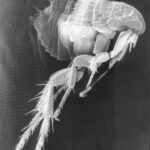The only way to understand how to eradicate cat fleas from your pet and your home is by understanding the life cycle of the flea. These are opportunistic pests willing to bide their time until the environment is just perfect for them to grow and develop. To improve your chances of winning against these insect pests you will need a flea treatment which targets as many life stages as possible. Even then, you simply cannot destroy them all. Once the fleas move onto the next stage you will have to treat for them again.
There are four stages in the life-cycle of the cat flea; eggs, larvae, pupae and adult.
Eggs are usually laid on your pet but then drop off to settle in carpets and soft furnishings. The hard shell of flea eggs mean very few pesticides are able to destroy them. Eggs will lie dormant from a fortnight up to three months waiting for environmental conditions to be just right before developing further. If you use a pesticide which does not kill flea eggs, they are likely to hatch and re-infest your home and pet over the next few months.
Flea larvae hatch from the egg to feed on flea dirt and other organic debris on your pets, carpets and soft furnishings. They usually remain at this stage of their life-cycle for a few weeks. Regular vacuuming is one way to reduce the amount of food available for them.
Flea pupae are silk cocoons in which larvae develop into adult fleas. The pupa tend to be hidden deep in the pile of carpets where we tend not to focus our flea treatments. The pupa can reside in your home for up to a year waiting for conditions to be suitable for the emerging adult flea.
Adult fleas emerge from the pupa when they sense warm blooded creatures are near. They immediately hop onto the nearest suitable host, begin feeding and laying eggs. Each female will lay up to 600 flea eggs.
Any cat flea treatment must be ongoing. As you can see each stage of flea is able to wait and re-emerge when conditions are favorable. You may not see a flea for three months, but if you discontinue flea prevention within three months all the flea eggs in your home will begin hatching and restart the whole cycle again.
The more different stages of fleas, a flea treatment destroys, the more expensive it is. You can save a lot of money by using a product which only destroys flea eggs and larvae. But, you will have to make an initial treatment with another product to eliminate adult fleas too. Long-term your cheap treatment to kill the juvenile stages of fleas should keep your home flea free. However, any pets going outside or visiting from outside are likely to bring new adults into your home.
By understanding just how easy it is for juvenile fleas to wait for the right conditions you now know a cats flea treatment is always an ongoing project.
For more information about cats flea treatment along with secondary cat flea and tick problems visit the Cat Flea & Tick Treatment site.



